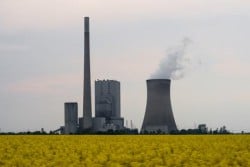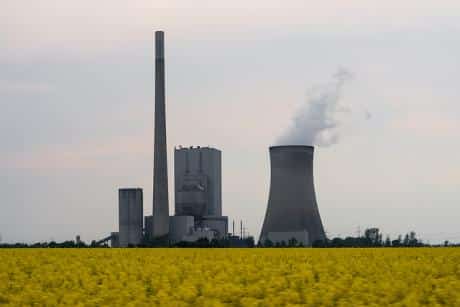by Oliver Munnion, Our Kingdom

Energy companies are exploiting “clean coal” myths to justify dirty developments and profit from lucrative subsidies. photo: Flickr/Martin
In the UK, a new coal fired power station is being developed by Drax that, if built, would be the first new coal fired power station to be switched on since Drax’s existing power station opened in 1974. This is surprising given that there were mass protests against new coal in the UK that saw a whole new generation of coal fired power stations stopped in their tracks. Yet plans for Drax’s new “White Rose” power station are proceeding largely unopposed. This is because, as will be discussed below, the UK public has been fooled by the rhetoric of “clean coal”, “bioenergy with carbon capture and storage”, and “negative emissions”
The White Rose Carbon Capture Project is a proposed 428 MWe power station capable of burning both coal and biomass, that developers say will capture 90% of the carbon it emits, and store it safely under the North Sea. According to Drax, it will co-fire up to 15% wood with coal. But it will in fact be allowed to burn any proportion of coal and wood. The power station will use “Oxyfuel Combustion”, one of a number of different carbon capture technologies that extracts some of the CO2 coming out of the smokestack.
The principal company behind the White Rose is Drax Plc, operators of the UK’s largest coal-fired power station and now also the world’s largest biomass power station – the other partners are Alstom, BOC and National Grid. White Rose is currently making its way through the planning system, and has attracted widespread support from policy makers, industry, and even some green groups. It has already received £50 million from the UK Government for feasibility studies, been guaranteed EUR 300 by the European Commission (if CO2 is captured), and is set to receive up to £900 million of UK tax payer’s money by the end of the year for upfront construction costs. On top of this, Drax expect to be awarded a very generous “Contract for Difference”, the UK Government’s subsidy mechanism that will include electricity generated with carbon capture technology.
Bioenergy with Carbon Capture and Storage (BECCS) and Negative Emissions
On the White Rose website is the bold proclamation that:
“By co-firing biomass to the extent of the 10% CO2 not captured, it will be possible to reduce the CO2 emissions impact of the plant even more and potentially achieve a plant with negative CO2 emissions.”
This “negative emissions” rhetoric is reflected elsewhere, for example in the White Rose developers’ written evidence to the UK’s Energy and Climate Change Committee:
“The combination of biomass and CCS for power generation even offers the even more exciting prospect of negative emissions…
In the longer term, CCS combined with biomass is the only low carbon technology that could remove industrial quantities of CO2 from the atmosphere and permanently store it in deep geological formations. CO2 is absorbed from the atmosphere during the natural growth process of biomass. Following combustion of the biomass the CO2 is captured and permanently stored providing a net carbon removal from the atmosphere, or “negative emissions”. These negative emissions could be used to offset emissions from other harder to decarbonise sectors.”
Needless to say, industry lobby groups, such as the Global CCS Institute, areusing the same rhetoric about the White Rose project:
“…in addition to capturing nearly 90 per cent of its carbon emissions, under the right circumstances it could reach zero or even negative emissions… This project, and several others at advanced stages of planning in the UK and mainland Europe, have the potential to reinvigorate CCS in Europe and help meet the world’s climate targets.”
Is this just opportunism on the part of an industry desperate to keep on burning things, or is it taking a lead from elsewhere? In fact, the Intergovernmental Panel on Climate Change is partly responsible for the hype around Carbon Capture and in particular Bioenergy with Carbon Capture and Storage (or BECCS).
The IPCC’s Working Group 3 report summary in 2014 effectively says that if we want to have any realistic chance of limiting global warming to 2 degrees above pre-industrial levels (still alarmingly high), we would need emissions reductions as well as some sort of technology to actually remove CO2 from the atmosphere. Bioenergy with Carbon Capture and Storage (BECCS) is singled out as the most realistic and ‘important’ approach, in combination with ‘afforestation’.*
“Mitigation scenarios reaching about 450 ppm CO2eq in 2100 typically … rely on the availability and widespread deployment of BECCS and afforestation in the second half of the century.”
Although they do qualify this by saying that:
“There is only limited evidence on the potential for large scale deployment of BECCS, large scale afforestation and other CDR technologies and methods.”
What the White Rose Project shows is that hype around BECCS and “negative emissions” technologies is already being exploited by companies to attract government subsidies.
What are the chances of the White Rose actually achieving “negative emissions”? Not good.
Total and Vattenfall have tried and rejected the White Rose’s carbon capture technology as economically not viable due to the large amount of energy used in the process, and have withdrawn investment into it. Furthermore, an oxyfuel plant like the one Drax plans to build can be run far more cheaply and easily without capturing CO2. There are numerous ways that the White Rose could be legally operated without anywhere near 90% capture, or even without any carbon capture at all. For example, under EU and UK legislation, all of the CO2 emitted from burning wood is classed as ‘carbon neutral’ and the White Rose plant could therefore meet UK emissions standards by simply burning 50% wood, 50% coal and capturing no carbon at all. Next is the issue of storage – whilst it might be technically feasible to scrub CO2 out of smokestack emissions, there is no convincing evidence that CO2 stays put when injected into geological formations. And finally, there’s the issue of the damage done by coal mining and wood extraction for the White Rose’s fuel. No level of corporate greenwash can make these processes “clean” or “green”.
An expensive White Elephant
So far no oxyfuel plant bigger than 30 MW (14 times smaller than the proposed White Rose project) has been built anywhere in the world. The US government has just pulled the plug on a smaller but otherwise identical planned power station, having wasted $202.5 million (£131 million) on it. The project was abandoned due to cost-overruns, delays, and because private sector investors were unwilling to contribute funds to such a project. No other projects of this type have attracted any private or public sector funding.
By pouring up to £1 billion into the White Rose, the UK will be left with a large, polluting, white elephant. Rather than a “clean” plant achieving “negative emissions”, UK citizens will be tricked into underwriting a brand-new, filthy, greenhouse gas spewing, coal and biomass power station.
The true cost of the White Rose
While the public is led to believe they are supporting a climate friendly project, in fact the White Rose, even with a very optimistic 90% CO2 capture rate, would still be increasing emissions. But the true costs of this project will be in the extra coal and biomass that will be burned at the power station. The White Rose will get its fuel from the stockpiles at the adjacent Drax power station, from the same Drax supply chains. This includes coal mined in Russia, the US and Colombia, as well as the UK, and biomass predominantly from the US and Canada.
Currently, Drax is planning to keep its existing coal and biomass plant operating until 2039, with no closure plans for its remaining 3 coal units. Even with effective carbon capture, the plan therefore is to emit more, and not less CO2, through the operation of the White Rose. The new power station will create a new long-term demand for coal, additional to that of the existing power station. This will only exacerbate the impacts of coal mining worldwide, including in northern Colombia where villages have been forcibly evicted for an opencast mine that supplies Drax, and where water depletion and pollution, and coal dust pollution, have devastated communities’ ability to grow food and feed themselves. At other mines in Colombia, companies have been directly implicated in the funding of paramilitary violence and murder of trade union activists.
Drax already burns more wood than any other power station in the world, and wood pellets could make up to 15% of the fuel burned in the White Rose. The vast majority of the wood that Drax burns is imported from the southern US and Canada, with imports expected to increase significantly as new pellet facilities begin production. Even at the early stages of growth for this industry, whole trees are being turned into pellets. Scientists and US conservation NGOs have shown that Drax is sourcing pellets directly linked to the clearcutting of highly biodiverse and carbon rich swamp forests in the southern US.
The claim that burning biomass is “low carbon” or even “carbon neutral” at the point of combustion has also been shown to be totally false. If evidence collected on the wood sourcing of Drax’s main supplier in the US, Enviva, is applied to the UK government’s own recently published biomass carbon calculator, it can be shown that a significant proportion of wood that Drax burns results in up to 3 times more carbon emissions than equivalent generation from burning coal.
The impacts of the huge expansion of the wood pellet industry are likely to be felt more widely. As European and North American wood is increasingly burned in power stations, paper companies are looking to the global South for their wood sourcing, from countries such as Brazil. More directly, the Brazilian company Tanac SA has reported entering into a sourcing agreement with Drax which will see the company build a large pellet plant, which is likely to result in the expansion of monoculture tree plantations in the Brazilian state of Rio Grande do Sul. Monoculture tree plantations in Brazil are associated with the displacement of indigenous and traditional communities, deforestation, water and soil depletion, and pollution.
Regardless of whether the White Rose power station captures any carbon, it will increase carbon emissions from forest degradation and logging, and from coal mining.
Campaign update
On June 18, campaigners inflated a giant white elephant carrying the message “No public funds for coal and biomass” outside the offices of the Department of Energy and Climate Change in London. The activists were delivering a petition signed by almost 114,000 people that called on the UK Government not to support the White Rose Project with a grant that would cover most of the costs of the project’s implementation. The message was a simple one: public funds should not be wasted on expensive new thermal power stations, using technology that others have dismissed as unviable, and locking us into more coal and biomass sourcing long into the future.
You can read more about the White Rose Project here, and by downloading Biofuelwatch’s briefing.
In conclusion
The White Rose Project is a worrying case study of how international hype around BECCS and CCS is being exploited by energy companies to justify dirty developments and profit from lucrative subsidies. These developments have very little to do with achieving “negative emissions”, and everything to do with turning climate change into a deceitful business opportunity.
* ‘Afforestation’ means planting trees where there have been no forests for at least 50 years – and in practice it means large-scale tree plantations on grassland, farmland, etc. Thus, far from a benign alternative, so-called afforestation threatens small farmers, pastoralists and other communities as well as ecosystems and biodiversity – just as large-scale bioenergy, including for BECCS does.



